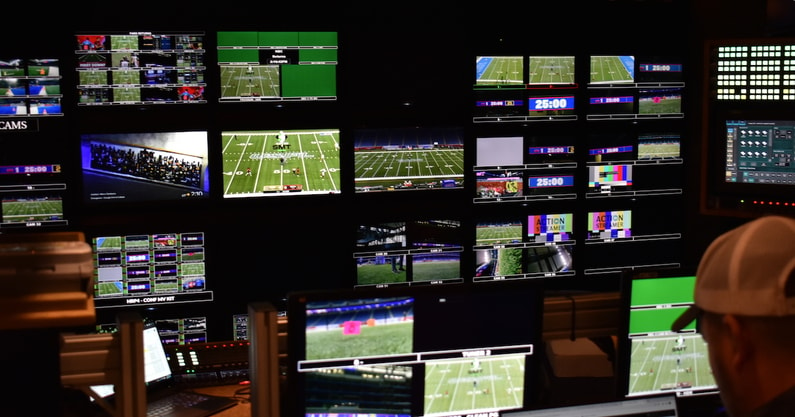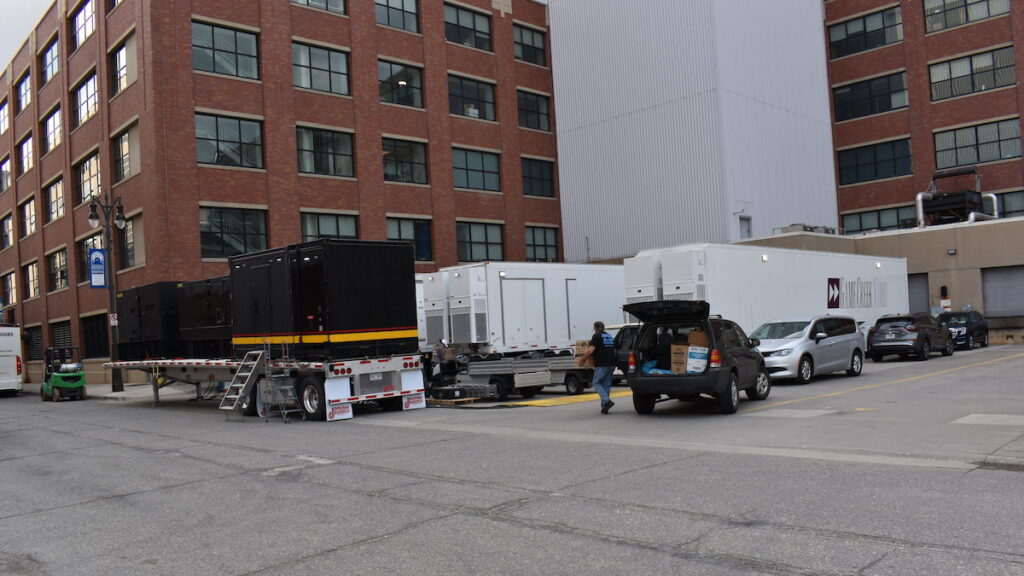Behind the scenes of FOX Sports’ envelope-pushing USFL broadcasts

DETROIT — It’s less than 10 minutes until kickoff between the Michigan Panthers and Birmingham Stallions at Ford Field on May 20 and the camera feeding to channel 13 back in the FOX production trucks is still on the fritz. At 3:53 p.m., seven minutes before this Week 6 USFL game is set to air on FOX, coordinating technical producer Chance Kulis makes a decision.
After spending the previous 90 minutes troubleshooting, getting feedback, strategizing with folks at FOX’s production headquarters on the West Coast, and then troubleshooting some more, it’s clear the issue won’t be resolved by the time the game will be beamed to thousands (even millions) of screens across the country. Kulis and his crew hardwired the field-level steadicam that had been malfunctioning, sacrificing another camera until they could solve the problem. Frustration was evident, as was some necessary good humor.
“Tell Krusty to stand down but I appreciate his enthusiasm,” Kulis said after making the decision. “You can tell him that verbatim.” Chuckles ensued in the darkened production truck as the message was relayed.
Thus is life for the behind-the-scenes battalion of producers, engineers, camera operators and all the others putting on FOX’s USFL coverage. In putting on a broadcast with so much varied technology, it’s inevitable that something goes awry — and it’s when the hundreds of years of collective experience on the crew becomes invaluable.
In the second season of USFL football in the 21st century, FOX is pushing the boundaries with access — i.e., where they can get a camera or microphone — with their broadcasts.
The production team is tapped into the team radio channels for coaches, numerous players are mic’d up and there are cameras on the referees hats and even in the helmets of some players. There’s also the USFL rules headquarters for replays, plus FOX’s own football rules analyst, Mike Pereira. When simulcasting games on FOX and NBC, there are 113 different channels for media to be transmitted through. And on this particular Saturday, there’s approximately four dozen cameras set up around Ford Field.
“And because you have all that information, it’s really about telling the story that needs to be told right now,” said Brad Cheney, FOX Sports’ vice president of field operation and engineering. “These producers and directors don’t have time to come up and, and, and develop the story afterwards and go, you know what? This is the storyline. No, no, no, no. They’re doing this live with our sideline people and our announcers and all this coverage that we have. Because in the end, in order to do this well, on our biggest weeks we’re a 54-camera show.”
To make all these pieces of hardware work together is a challenge unto itself, both for the humans fine tuning the equipment and due to the bandwidth demands. With different types of cameras used on the broadcast, the color space needs to be aligned so each shot looks the same and there aren’t mismatching colors. Being in a dome with consistent lightning helps, as does a logistical quirk of the USFL.
Currently, the USFL features eight teams playing from four “hub” cities: Detroit and Memphis along with Birmingham, Alabama and Canton, Ohio. By the May 20 game at Ford Field, the trio of production trailers and array of cameras had been in place for four weeks running, cutting back on setup time.
As for bandwidth demands, a server in the trailer used mostly for storage during transport whirs away, churning out enough computing power to seemingly run NORAD. To power this TV production nucleus, everything is wired in to get power from Ford Field. But if that fails, a flatbed with three industrial generators is already plugged in and on standby.

All of the hardware incorporated into the broadcast is aimed at giving viewers an enhanced understanding and glimpse into what is going on, as well as differentiating the product from other football broadcasts. Picture quality is also a selling point, as it’s being broadcast in 1080p HDR.
“And sometimes you have two sky cams and it’s those guys understanding what’s happening to put their cameras in the right spots, and then you add a drone in and you have three cameras that are independently moving, you know, in 3D space,” Cheney said. “And there’s a lot that goes into making that happen. But, you know, it’s been really amazing from a coverage standpoint in keeping the viewer understanding what’s going on.”
With the mics, viewers hear the play call and discussion with coaches in the booth (they also have cameras on the coaches in the booths). And unlike the NFL, where the audio cuts off to the players with 15 seconds on the play clock, the USFL audio link stays open through the play.
This feature came into its own at the end of the first half on Saturday when Michigan Panthers quarterback Josh Love faked a spike and was stopped short of the line to gain on fourth down with seconds remaining. As the teams went to the locker room, Love and head coach Mike Nolan were on the mics, where Love was insistent he had been told by a coach to not spike the ball.
The access also shows up in the form of in-game interviews. While coaches are mostly off-limits until between quarters or at halftime, players are fair game. During the first half on Saturday, FOX sideline reporter Devin Gardner sat on the bench with Birmingham quarterback Alex McGough and did a brief interview. Also, the cameras are allowed to be closer to the action, even going in the huddle and staying on the field during play.
Along with access for the broadcast, the USFL is deploying a technology similar to the goal line technology that’s quickly become the norm in global soccer. With an RFID chip in the football and mapping of the field, the system quickly churns out a digital picture of how far upfield the ball went.
The production trailers themselves are impressive technology in their own right, with each costing well north of $1 million and packed with various computers, monitors, comms panels and other tech. The three form a mobile nerve center for the broadcast, with dedicated spaces for more than a dozen people to do their work.
They’re also the main connection between the FOX Sports HQ and this production detachment, an uplink managed by transmission engineer Bill Moore, who sat beside Kulis at the front of the booth during the game. Everything that is being captured by a camera or microphone is being channeled back to the headquarters, where the live direction and producing of highlight packages and such takes place. And it all runs through the controls at Moore’s fingertips.
And for all the tech, it’s people like Moore that make the whole operation sing — and still feel familiar.
Similarly, in the broadcast booth, Kevin Kugler and Joel Klatt are known commodities for football fans, as is Pereira as a rules analyst.
And behind the scenes, the platoon of people working diligently to troubleshoot a camera issue made sure the viewer at home couldn’t perceive it.. While starting the broadcast short a camera feels like failure to some in the production booth, what matters most is that the product showing up on FOX that afternoon was crisp, clean, and taking the viewer as close to the action as possible.
That much was achieved. And by the third quarter, the missing camera was brought back online.
“The little show that could,” Moore said amid the troubleshooting.